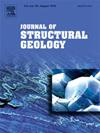Multiscale characterization of fracture network in sub-seismic faults (Monte Capanne Pluton, Elba Island, Italy)
IF 2.9
2区 地球科学
Q2 GEOSCIENCES, MULTIDISCIPLINARY
引用次数: 0
Abstract
Prediction of sub-seismic fault properties is a key factor to mitigate the uncertainties in reservoir modeling. The present study focuses on the geometry and origin of the NE-trending sub-seismic faults in Monte Capanne pluton (Elba Island, Italy), characterized by transtensive kinematics and developed in an interacting sector between two regional-scale faults. A detailed analysis of the fracture network (digitized fractures >10,000) was conducted along and across the NE-trending faults using Digital Outcrop Model (DOM). This dataset was further integrated with field mapping at a 1:200 scale of four representative sectors. Overall, our multiscale mapping identifies three different fault-related fracture sets: (i) NE-SW-trending fractures, (ii) E-W-trending fractures, and (iii) NNW-SSE-trending fractures. Statistical analysis of fracture orientation and length in DOM reveals a heterogeneous spatial distribution of deformation in the outcrop, showing an increase in fracture density and intensity (P10 and P21), and connectivity (connections per branch CB) towards the northeastern region of the outcrop, where NE-trending faults are closely spaced. A comparison between DOM-based and DOM-integrated datasets reveals that the former tends to underestimate small-scale fractures due to pixel-resolution limit (truncation effect), leading to an underestimation of across-fault damage zone width and internal fracture density and intensity. However, the proportion of connected nodes (X, Y) and connectivity (CB) from the DOM-based dataset is consistent with topological parameters from the DOM-integrated dataset. This study highlights the necessity of a multiscale approach for fracture network characterization in sub-seismic faults, combining DOM with field mapping to develop reliable templates for reservoir analysis.
意大利厄尔巴岛Monte Capanne Pluton次地震断层断裂网络的多尺度表征
亚地震断层性质预测是降低储层建模不确定性的关键因素。本文研究了意大利厄尔巴岛Monte Capanne岩体北东向次地震断裂的几何形态和成因,该次地震断裂具有横向运动学特征,发育于两条区域尺度断裂之间的相互作用板块。利用数字露头模型(DOM)对北东向断裂进行了详细的裂缝网络(数字化裂缝>; 10000条)分析。该数据集进一步与四个代表性部门的1:200比例尺的实地测绘相结合。总的来说,我们的多尺度映射确定了三种不同的断层相关裂缝组:(i) ne - sw走向裂缝,(ii) e - w走向裂缝,(iii) nnw - se走向裂缝。DOM中裂缝方向和长度的统计分析表明,露头变形的空间分布不均匀,裂缝密度和强度(P10和P21)增加,连通性(每分支CB的连接)向露头东北地区靠拢,ne向断裂密集分布。基于dom的数据集与集成dom的数据集的对比表明,由于像素分辨率的限制(截断效应),前者往往低估了小尺度裂缝,从而低估了断层间损伤带宽度、内部裂缝密度和强度。然而,基于dom的数据集的连接节点(X, Y)和连通性(CB)的比例与dom集成数据集的拓扑参数一致。该研究强调了亚地震断层裂缝网络表征的多尺度方法的必要性,将DOM与现场测绘相结合,为储层分析开发可靠的模板。
本文章由计算机程序翻译,如有差异,请以英文原文为准。
求助全文
约1分钟内获得全文
求助全文
来源期刊

Journal of Structural Geology
地学-地球科学综合
CiteScore
6.00
自引率
19.40%
发文量
192
审稿时长
15.7 weeks
期刊介绍:
The Journal of Structural Geology publishes process-oriented investigations about structural geology using appropriate combinations of analog and digital field data, seismic reflection data, satellite-derived data, geometric analysis, kinematic analysis, laboratory experiments, computer visualizations, and analogue or numerical modelling on all scales. Contributions are encouraged to draw perspectives from rheology, rock mechanics, geophysics,metamorphism, sedimentology, petroleum geology, economic geology, geodynamics, planetary geology, tectonics and neotectonics to provide a more powerful understanding of deformation processes and systems. Given the visual nature of the discipline, supplementary materials that portray the data and analysis in 3-D or quasi 3-D manners, including the use of videos, and/or graphical abstracts can significantly strengthen the impact of contributions.
 求助内容:
求助内容: 应助结果提醒方式:
应助结果提醒方式:


